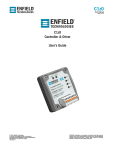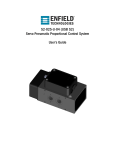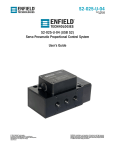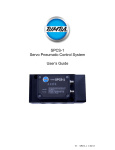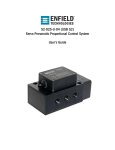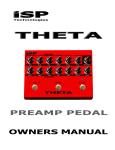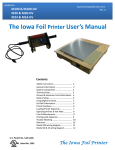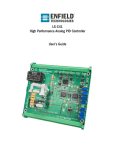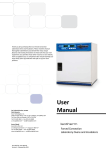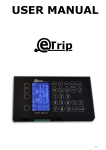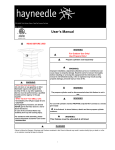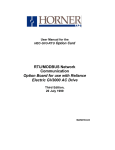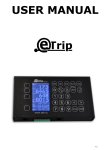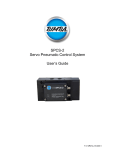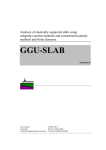Download C1 Controller & Driver User`s Guide
Transcript
C1 Controller & Driver User’s Guide C1 User’s Manual Page 1 of 12 Table of Contents Warnings & Notices 2 Quick Start Procedure 3 Factory Default Settings 4 System Setup Position 5 Force 5 Pressure 5 Flow 6 Wiring 7 Potentiometers/Tuning 8-9 Jumpers 10 Troubleshooting 11 © 2012 Enfield Technologies As Enfield Technologies strives for continuous improvement and dedication to product development, specifications are subject to change v20120816 WARNING: Installation and operation of electronic and high pressure systems (fluids and compressed gas) involves risk including property damage and personal injury or death. Users should be properly trained or certified and take safety precautions. C1 User’s Manual Page 2 of 12 Warnings & Notices WARNING: Installation and operation of electric and high pressure systems (fluids and compressed gas) involves risk including property damage and personal injury or death. Installers and users should be properly trained or certified and take safety precautions. This product may cause death, personal injury, or property damage if improperly used or installed. The information in this document and other information from Enfield Technologies and its authorized representatives are intended for use by persons having technical expertise in selecting and using these products. Product owners (“you”) should analyze all technical and safety requirements of your specific application, including the consequences of any possible failure, before selecting a product. This product may not be suitable for all applications, such as those acting upon people. Suitability is solely your responsibility. Because the requirements for each application may vary considerably, you are solely responsible for conducting any testing or analysis that may be required to determine the suitability of the product for your application, and to ensure that all performance, safety and warning requirements for your application are met. Caution: While the product is low voltage, it contains open-frame electronic components and care should be taken to prevent unintentional contact with the product to avoid damage to person or property. The C1 is an electro-static sensitive device. Use appropriate electro-static discharge (ESD) procedures during handling and installation. Notice: Use and purchase of this product is subject to Enfield Technologies’ Terms and Conditions of Sale and Use. Improper installation or use voids warranty. Consult factory regarding special applications. Specifications are subject to change. Reasonable efforts have been made to provide useful and correct information in this document, but this document may contain errors and omissions, and it is subject to change. Contact: Enfield Technologies 35 Nutmeg Drive Trumbull, CT 06611 USA +1 203 375 3100 +1 800 504 3334 toll free North America [email protected] www.enfieldtech.com © 2012 Enfield Technologies As Enfield Technologies strives for continuous improvement and dedication to product development, specifications are subject to change v20120816 WARNING: Installation and operation of electronic and high pressure systems (fluids and compressed gas) involves risk including property damage and personal injury or death. Users should be properly trained or certified and take safety precautions. C1 User’s Manual Page 3 of 12 Quick Start Procedure 1. Configure Jumpers a. Configure the left side of Jumpers 2 and 3 to select a command input of 0…10Vdc or 4…20mA b. Configure the right side of Jumpers 2 and 3 to select a command input of 0…10Vdc or 4…20mA c. Configure Jumper 1 to select control algorithm 2. Wire Feedback a. For 4…20mA signals: 4mA should correspond to the minimum feedback value and 20mA should correspond to the maximum feedback value. Also, for 4…20mA signals, low side should connect to ground. b. For 0…10V signals: 0V should correspond to the minimum feedback value and 10V should correspond to the maximum feedback value 3. Wire Command 4. Wire Power 5. Connect Pneumatic Lines a. Connect valve ad shown in “system setup” b. Inlet air should be dry (-40F dew point) non-lubricated air, non-flammable & non-corrosive dry gases (0.3 micron fine grade coalescing filter with 5 micron pre-filter) at 0-150psig. 6. Tune System a. Restore potentiometers to factory default settings b. Tune System 7. Troubleshooting a. See “Troubleshooting” b. Contact Enfield Technologies for additional help © 2012 Enfield Technologies As Enfield Technologies strives for continuous improvement and dedication to product development, specifications are subject to change v20120816 WARNING: Installation and operation of electronic and high pressure systems (fluids and compressed gas) involves risk including property damage and personal injury or death. Users should be properly trained or certified and take safety precautions. C1 User’s Manual Page 4 of 12 Factory Default Setting Potentiometer Factory Default Condition Setting RP1 – Proportional Gain RP2 – Ramp Rate RP3 – Minimum Feedback RP4 – Maximum Feedback Fully Counter Clockwise Fully Counter Clockwise Fully Counter Clockwise Fully Clockwise Proportional gain is zero Command is not being ramped No Adjustment to Minimum Position No Adjustment to Maximum Position Jumper Factory Default Condition Setting J1 – Control Algorithm Configuration #1 J2 (left side) - Command J3 (left side) - Command J2 (right side) - Feedback J3 (right side) - Feedback Jumper Off Jumper Off Jumper Off Jumper Off RP1 = Proportional Gain; RP2 = Ramp Rate RP3 = Minimum Feedback; RP4 = Maximum Feedback 0…10V Command 0…10V Command 0…10V Feedback 0…10V Feedback LED Factory Default Condition Setting Power Status On Off Power is On Not Status or Fault Indications © 2012 Enfield Technologies As Enfield Technologies strives for continuous improvement and dedication to product development, specifications are subject to change v20120816 WARNING: Installation and operation of electronic and high pressure systems (fluids and compressed gas) involves risk including property damage and personal injury or death. Users should be properly trained or certified and take safety precautions. C1 User’s Manual Page 5 of 12 Position or Force Control Pressure Control © 2012 Enfield Technologies As Enfield Technologies strives for continuous improvement and dedication to product development, specifications are subject to change v20120816 WARNING: Installation and operation of electronic and high pressure systems (fluids and compressed gas) involves risk including property damage and personal injury or death. Users should be properly trained or certified and take safety precautions. C1 User’s Manual Page 6 of 12 Flow Control © 2011 Enfield Technologies As Enfield Technologies strives for continuous improvement and dedication to product development, specifications are subject to change v20110311 WARNING: Installation and operation of electronic and high pressure systems (fluids and compressed gas) involves risk including property damage and personal injury or death. Users should be properly trained or certified and take safety precautions. C1 User’s Manual Page 7 of 12 Wiring Pin 1 2 3 4 5 6 7 8 Label +Pwr Gnd M+ MCmd Fbk N/A +10 Function +12…24VDC, power supply connection common (dc ground), connect to power supply common Valve+ (brown) Valve- (blue) Command Input Feedback Input Not Used +10Vdc Excitation © 2011 Enfield Technologies As Enfield Technologies strives for continuous improvement and dedication to product development, specifications are subject to change v20110311 WARNING: Installation and operation of electronic and high pressure systems (fluids and compressed gas) involves risk including property damage and personal injury or death. Users should be properly trained or certified and take safety precautions. C1 User’s Manual Page 8 of 12 Potentiometers/Tuning much derivative can cause the system to undershoot and “creep” into the target position or become unstable. Integral Gain – By adjusting the integral gain, the user can reduce the steady state error of the system. Integral gain be increased or decreased by turning the potentiometer clockwise or counterclockwise, respectively. Too little integral gain can result in steady state error while too much integral gain can cause oscillations and overshoot. Ramp Rate – By adjusting the ramp rate, the user can set the ramp rate of the command input to the controller. The ramp rate be increased or decreased by turning the potentiometer clockwise or counterclockwise, respectively. A high ramp rate results in a slower rise time while a lower ramp rate results in a faster rise time. The C1 has 4 potentiometers (RP1, RP2, RP3 and RP4) which allow the user to adjust different gains depending on jumper configuration. For instructions on how to switch between configurations see the Jumper Configurations section. A polymer non-conductive screwdriver is the preferred method for adjusting the potentiometers. Care should be taken not to allow metal screwdrivers to touch other components on the board. Minimum Feedback – By adjusting minimum feedback, the user can offset the minimum feedback value for the controller. For feedback sensor with a minimum output greater than 0V or 4mA, this adjustment should be used. The minimum feedback be increased or decreased by turning the potentiometer clockwise or counterclockwise, respectively. For sensors that do not require any offset, this potentiometer should be set fully counter clockwise. Proportional Gain –By adjusting the proportional gain, the user can adjust the responsiveness of the system to changes in command or feedback. The responsiveness of the system can be increased or decreased by turning the proportional gain clockwise or counterclockwise, respectively. A gain that is too low can result in an unresponsive system while a gain that is too high can cause the system to become unstable. Derivative Gain – By adjusting the derivative gain, the user can set the damping applied to the system. This damping can be increased or decreased by turning derivative gain clockwise or counterclockwise, respectively. Damping helps reduce overshoot and smoothes out system performance. However, too © 2011 Enfield Technologies As Enfield Technologies strives for continuous improvement and dedication to product development, specifications are subject to change v20110311 Maximum Feedback – By adjusting maximum feedback, the user can offset the maximum feedback value for the controller. For feedback sensor with a maximum output less than 10V or 20mA, this adjustment should be used. The maximum feedback be increased or decreased by turning the potentiometer clockwise or counterclockwise, respectively. For sensors that do not require any offset, this potentiometer should be set fully clockwise. WARNING: Installation and operation of electronic and high pressure systems (fluids and compressed gas) involves risk including property damage and personal injury or death. Users should be properly trained or certified and take safety precautions. C1 User’s Manual Page 9 of 12 For a more detailed explanation of PID controls sell effects of increasing gains below. Without Tuning With Tuning Effects of Increasing Gains Parameter Rise time Overshoot Settling time Steady State Error Proportional Gain Decrease Increase Small change Decrease Integral Gain Decrease Increase Increase Eliminate Derivative Gain Small Change Decrease Decrease None Effects of Increasing Ramp Rate © 2011 Enfield Technologies As Enfield Technologies strives for continuous improvement and dedication to product development, specifications are subject to change v20110311 Effects of Decreasing Ramp rate WARNING: Installation and operation of electronic and high pressure systems (fluids and compressed gas) involves risk including property damage and personal injury or death. Users should be properly trained or certified and take safety precautions. C1 User’s Manual Page 10 of 12 Configure Potentiometers Jumper Configurations To configure jumpers remove lid for access Config #1 Config #2 J1 To switch bewtween control configurations 1. Remove air from the system. 2. Turn power off. 3. Move jumper to desired confiuration. 4. Turn power back on. 5. Upon powering, the red LED will be blinking quickly. 6. Turn all potentiometers fully counter clockise. 7. Grenn LED will blink four times slowly. This will indicate that the driver has switched configurations. Configure Command for 0…10Vdc J2 J3 Configure Command for 4…20mA J2 J3 Configure Feedback for 0…10Vdc J2 J3 Configure Feedback for 4…20mA J2 J3 © 2011 Enfield Technologies As Enfield Technologies strives for continuous improvement and dedication to product development, specifications are subject to change v20110311 WARNING: Installation and operation of electronic and high pressure systems (fluids and compressed gas) involves risk including property damage and personal injury or death. Users should be properly trained or certified and take safety precautions. C1 User’s Manual Page 11 of 12 Troubleshooting Symptom Probable Causes Corrective Action System Totally Unresponsive Power Not Applied Air Off Proportional Gain too Low Signal Wiring Apply power, check all power wiring Turn air on Turn Proportional Gain Clockwise Verify signal wiring for command and feedback; also verify mechanical system polarity Verify all Wiring Proportional Gain too Low Turn Proportional Gain Clockwise Power Supply Voltage not Stable Check power wiring; change power supply No Feedback Signal Connect Feedback Signal Verify all wiring is as shown in application examples and as described in the “System Setup” section of this document Inverted Polarity System Mildly Responsive or Sluggish System ‘Pegs’ or ‘Rails’ Feedback Connected Improperly System Fails to Converge or is Inaccurate System Oscillates System ‘Buzzes’ Incorrect Wiring Mechanical System Proportional Gain too Low Increase Integral Gain Maximum Feedback Set Incorrectly Minimum Feedback Set Incorrectly Air Leaks Valve Sticking Proportional Gain too High Integral Gain too High Valve Oversized for System Input Signal Noise (possibly 60Hz) Input Signals not connected DC Common not connected High Pitched Tone or Whine from Valve Dither Verify all wiring is as shown in application examples and as described in the “Installation” section of this document Consult Factory for Suggestions Turn Proportional Gain Clockwise Turn Integral Gain Clockwise Adjust the Maxiium Feedback Potentiometer Adjust the Maxiium Feedback Potentiometer Insure there are no air leaks in the system Insure that inlet air meets valve specifications. Turn Proportional Gain Counter Clockwise Turn Integral Gain Counter Clockwise Consult Factory Verify that large or high power machinery is not operating nearby. Also, verify input signal integrity by examining the signal with an oscilloscope. Verify all wiring as shown in the “System Setup” section of this document Verify all DC common connections This is an artifact of the built-in dither and is intended to keep the electro-mechanical device in constant motion. Warranty: This product is covered by a 1 year Enfield Technologies limited warranty. Contact Enfield Technologies or visit website for more details. Notice: Use and purchase of this product is subject to Enfield Technologies’ Terms and Conditions of Sale and Use. Improper installation or use voids warranty. This product may not be suitable for all applications, such as those acting upon people, and suitability is solely the buyer’s responsibility. Consult factory regarding special applications. © 2011 Enfield Technologies As Enfield Technologies strives for continuous improvement and dedication to product development, specifications are subject to change v20110311 WARNING: Installation and operation of electronic and high pressure systems (fluids and compressed gas) involves risk including property damage and personal injury or death. Users should be properly trained or certified and take safety precautions.












